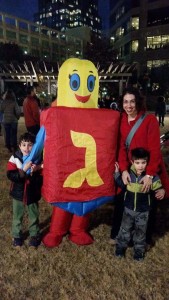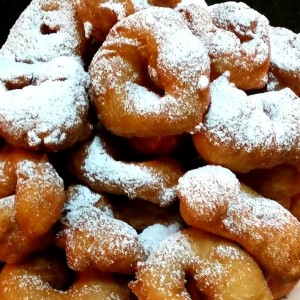Celebrating Hanukkah from Jerusalem to Greensboro
Nes gadol haya sham. These Hebrew words, which mean “a great miracle happened there,” are said by American Jews celebrating the Jewish holiday of Hanukkah, which falls on December 6-December 14. But when I lived in Israel, I said nes gadol haya po, which means “a great miracle happened here.” As the site of the events that inspired the modern-day holiday of Hanukkah, Israel is truly a unique place to celebrate the Festival of Lights.
In Jerusalem, where I lived for 14 years before moving to Greensboro, North Carolina, Hanukkah is considered a minor religious celebration, but one full and rich with cultural traditions of delicious holiday foods, festivals, and the flickering lights of numerous candelabra.
 The Hanukkah traditions that non-Jewish Americans are familiar with are few. Perhaps the most well-known are the story of one day of oil lasting eight days, eight days of presents for Jewish children, candles, and some vague knowledge that there must be traditional foods (“Isn’t there always special food for Jewish holidays?”), although an unscientific poll of friends showed no actual knowledge of what that food might be.
The Hanukkah traditions that non-Jewish Americans are familiar with are few. Perhaps the most well-known are the story of one day of oil lasting eight days, eight days of presents for Jewish children, candles, and some vague knowledge that there must be traditional foods (“Isn’t there always special food for Jewish holidays?”), although an unscientific poll of friends showed no actual knowledge of what that food might be.
Hanukkah celebrates a victory over all odds. On Hanukkah, the Jewish people remember the defeat of the mighty Greeks by a small band of Jewish warriors and the more well-known miracle of a small amount of oil lasting eight long days.
Hanukkah is a festive holiday everywhere, but in Israel is especially significant because the great miracle happened there.
Every night of Hanukkah, Jews light a nine-branched candelabrum called a Hanukkah menorah or Hanukkiah. Traditionally, we say a blessing thanking God before we light the flame each night until the menorah is ablaze on the eighth night of the holiday.
In the United States, most people use candles in the menorah, but in Israel, most light their Hanukkah flames using not candles, but wicks in olive oil – a more direct commemoration of the Hanukkah miracle of old. It is tradition to light the menorah at the entrance to your home, or in a window facing the street, so all passersby can see the Hanukkah lights shining bright, proclaiming the miracle of the oil for all to see.
 When you walk through the streets of Jerusalem on the evenings of Hanukkah, the darkened streets are lit by the flickering of hundreds of Hanukkah lights, the scent of burning oil, and the joyful sound of songs in Hebrew.
When you walk through the streets of Jerusalem on the evenings of Hanukkah, the darkened streets are lit by the flickering of hundreds of Hanukkah lights, the scent of burning oil, and the joyful sound of songs in Hebrew.
Just as in North Carolina the smell of evergreen trees and the spicy combination of cinnamon, orange, nutmeg, cloves, and vanilla signal the coming of Christmas, the smell of fresh donuts is the smell of Hanukkah in Israel.
And in Israel, the foods of the holiday are everywhere. Because the Hanukkah miracle is of a small amount of oil that lasted eight days, the holiday foods are fried in lots of oil. You might have heard of latkes – or fried potato pancakes – being served on Hanukkah. This was the holiday food I grew up with, patties of shredded potatoes and onion fried in bubbling oil, and served with homemade cinnamon applesauce and rich sour cream.
But latkes are only one of the traditional foods popular in Israel, a country to which immigrants came not only from Eastern Europe (Ashkenazi Jews), but from countries like Morocco, Iraq, and Yemen. The Mizrahi or Sephardi community, which makes up half of Israeli society, has food traditions unlike Ashkenazi Jews, who are the majority of the US Jewish community.
 Delicious fried doughnuts, called sufganiyot, are the most popular Israeli Hanukkah treat. Bakeries throughout the country display piles of fragrant rounds of fried dough, filled with jam, chocolate spread, or other sweet delights, and topped with powdered sugar. Sfenj, which somewhat resembles the sugar-topped funnel cakes served at the State Fair, is a traditional Moroccan treat popular for the holiday, and which most American Jews – let alone non-Jews – have never heard of.
Delicious fried doughnuts, called sufganiyot, are the most popular Israeli Hanukkah treat. Bakeries throughout the country display piles of fragrant rounds of fried dough, filled with jam, chocolate spread, or other sweet delights, and topped with powdered sugar. Sfenj, which somewhat resembles the sugar-topped funnel cakes served at the State Fair, is a traditional Moroccan treat popular for the holiday, and which most American Jews – let alone non-Jews – have never heard of.
My Kurdish former mother-in-law would always cook up steaming platters of not only potato latkes but carrot and leek fritters, which were traditional in her ancestral hometown of Zahko. Iranian or Persian Jews fry an herb and egg pancake called kuku sabzi, and Yemenites prepare the sugary syrup-coated donut called zalabiya.
These treats are hard to come by here in North Carolina, so I always make my own. After 14 years in Israel, and as the mother of children of Kurdish descent, it is part of my celebration of Hanukkah to fry donuts and fritters. (Recipes to follow)
When I moved to North Carolina I was shocked to discover that in the 14 years since I had been away, the use of an electric menorah had become popular – probably because of the Jewish minority here, and the ubiquitous Christmas lights.
In fact, the Hanukkah experience in the US today is influenced strongly by its calendrical proximity to Christmas. In Israel, and throughout the world, children do receive Hanukkah gelt (coins) made out of chocolate. Gift-giving is also becoming increasingly popular, but not quite like here. Just as Christmas has become a holiday of presents, and the season of gift-giving replaced the religious value of the holiday for many American Christians, this influenced American Jews. The feelings of good cheer and holiday gift-giving have become an important part of the Hanukkah celebration. And so I give my children one small gift every night of Hanukkah – directly after candle lighting – because we are American now.
But when we play the traditional game of dreidel in our home, the top we spin still proclaims nes gadol haya po – a great miracle happened here, because I want to bring the traditions of my children’s birth country into my North Carolinian house. I want them to experience the joy of an Israeli Hanukkah, even as we live in Greensboro, North Carolina.
Hanukkah Recipes!
Hillary’s Traditional Potato Latkes
5 russet potatoes
1 large Vidalia onion
2 eggs, lightly beaten
1 TB sour cream
¼ cup flour
1 teaspoon salt
Dash of freshly ground pepper
Oil for frying (¼ – ½ cup)
Directions:
Grate potatoes and onion finely, preferably using a food processer. Put the grated vegetables into a towel and squeeze out all the liquid. In a large bowl, place the lightly beaten eggs, and add the flour, sour cream, salt and pepper. Whisk together, and add the potato-onion mixture.
Heat oil in large frying pan over medium-high heat. Form about 2 TB of the mixture into a firm patty, and drop into hot oil, frying until golden on both sides. Latkes will need to be turned once with a slotted spatula. Place on paper towels to absorb excess oil, and pat.
Serve hot topped with warm cinnamon applesauce (homemade is always best!) or sour cream.
Kurdish Carrot and Leek Fritters
Fritters:
2 cups finely grated carrots (about 5-6 medium carrots)
1 cup finely sliced or grated leek
3 eggs
½ cup flour
¼ teaspoon black pepper (to taste)
1 teaspoon salt (to taste)
1 teaspoon coriander
Vegetable oil for frying
Topping:
1 cup plain yogurt
1 minced garlic clove
½ bunch of finely chopped dill
1 small finely grated cucumber (if using English cucumbers, 1/3 cucumber)
Salt and pepper to taste
Directions:
In a large bowl, mix carrots, leek, eggs, bread crumbs, salt and pepper together. In both hands, shape flat, round, fritters from the mixture.
Heat vegetable oil in a large frying pan. Fry fritters until golden brown on both sides, turning once with a slotted spatula. Place on paper towels to absorb excess oil, and pat.
Serve hot topped with yogurt mixture. Enjoy!
Moroccan Sfenj (fried donuts)
3 cups flour
2 teaspoons yeast
2 teaspoons sugar
1 teaspoon salt
1 1/4 cup warm water
Vegetable oil
Powdered sugar
Directions:
Mix the yeast, sugar, and ¼ cup warm water in a large mixing bowl (or bowl of mixer, if you have a mixer with a dough hook). When the yeast starts to froth, add the flour, and a dash of the remaining warm water, and begin to mix. Add additional warm water from time to time, until the dough is sticky yet firm. Knead, adding additional water as needed, until the dough is spongy and sticky, too soft to knead.
Place the dough in a lightly oiled mixing bowl, turning the dough until oiled. Cover with a towel or saran wrap, and rise for 2 hours, until at least double if not triple the original size.
In a large frying pan, heat the vegetable oil over medium-high heat. You can choose to make rings, balls, or any other shape with the dough. To make rings, break off a piece of dough slightly large than a golf ball, make a hole in the center, stretch the dough to make a ring, and drop in the boiling oil. Continue with additional dough, wetting hands with water to keep the dough from sticking. Fry the donuts until golden brown, turning once or twice. Remove with a slotted spoon and place on paper towels to absorb excess oil.
Cover with powdered sugar and serve hot.
By Guest Blogger Hillary Zaken

I just came across your article from 2015! How funny for me to stumble across an article containing the words “North Carolina” and “Zakho!” My son and daughter are also the grandchildren of Zakho, now living in the Triangle! Hag Sameach! Feel free to find me online and reach out if you’d like to get together for a foul-free playdate! ????